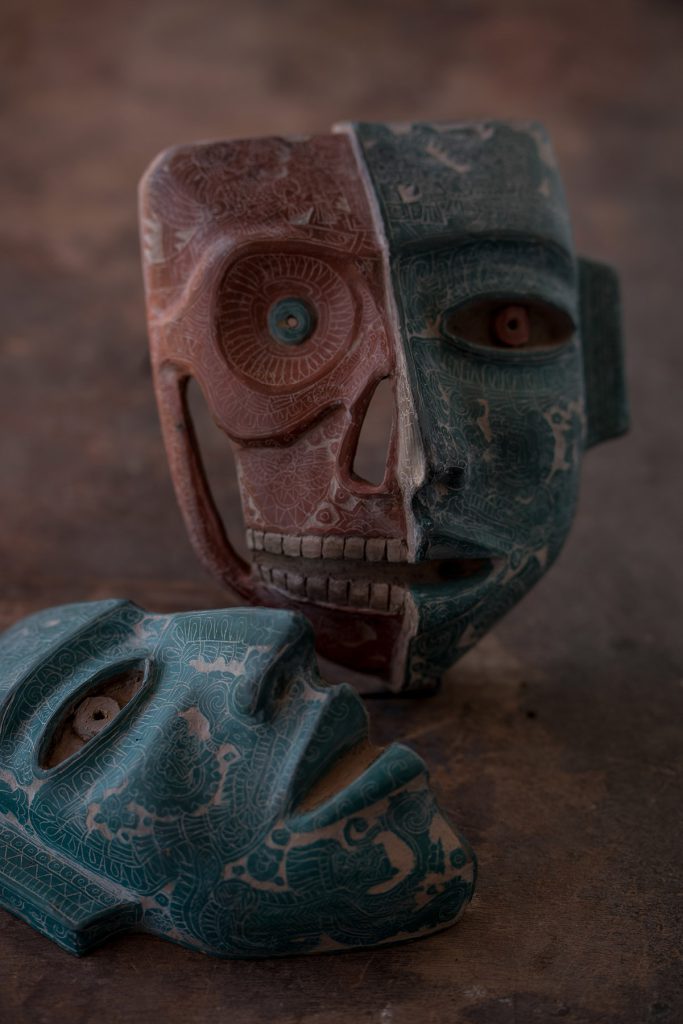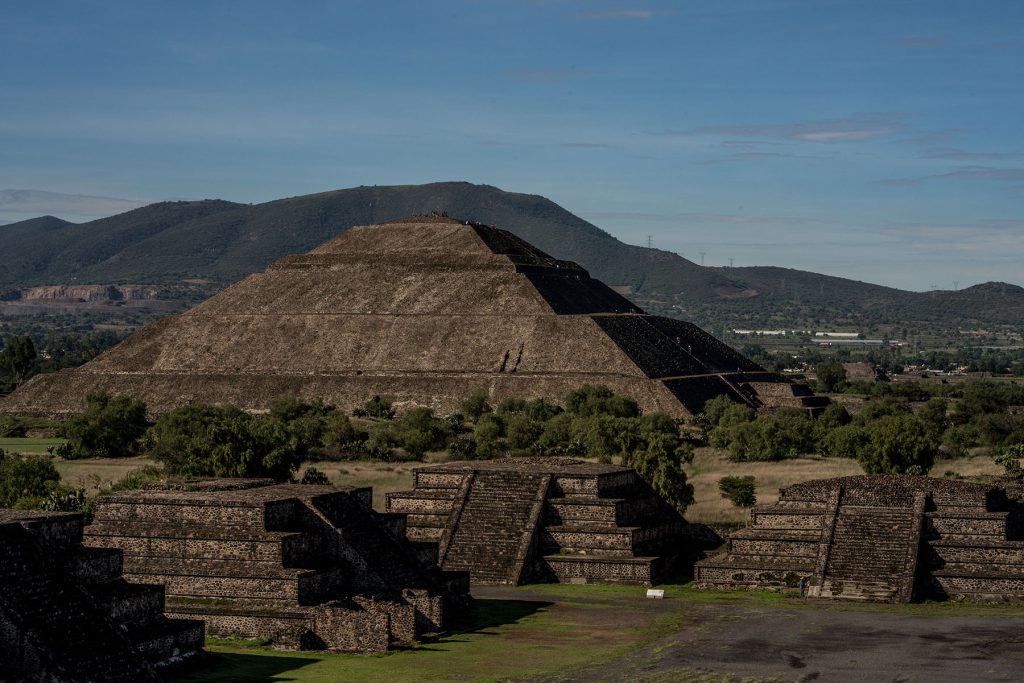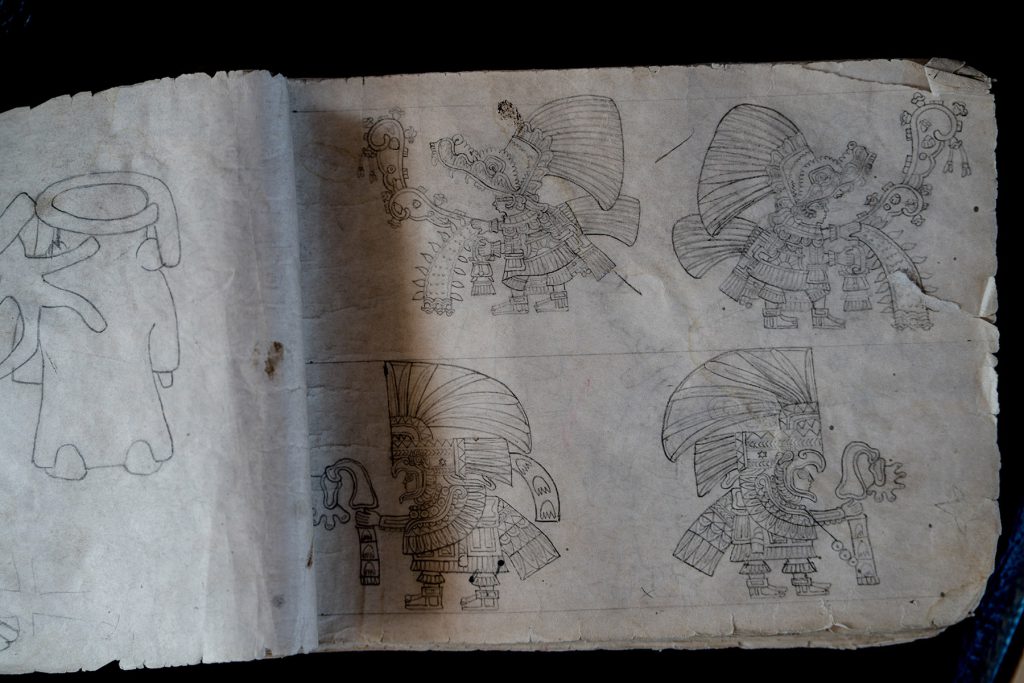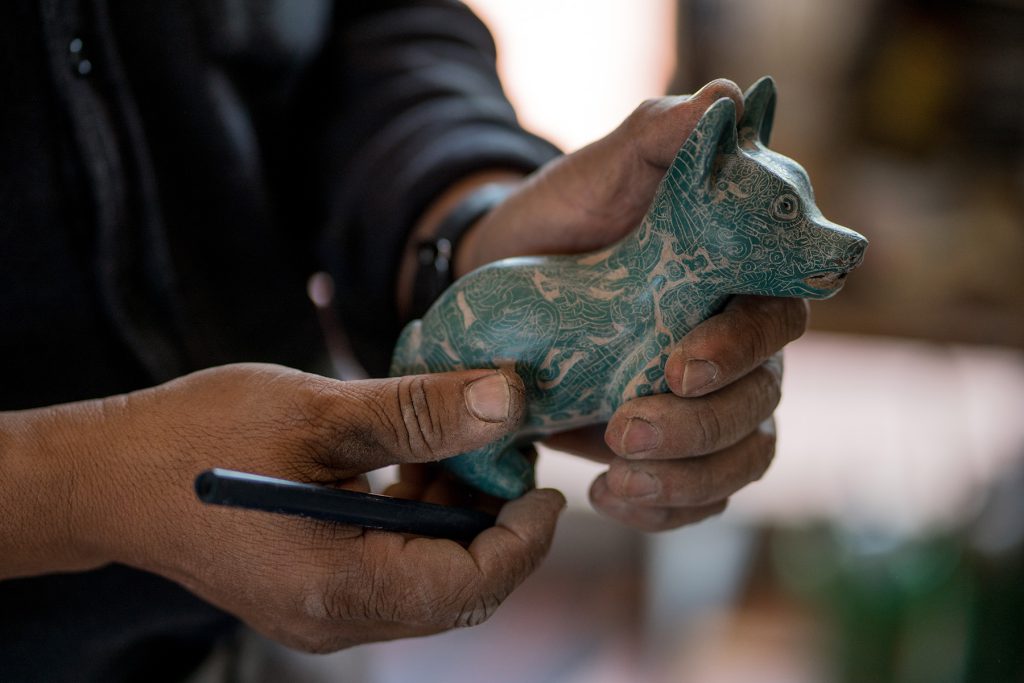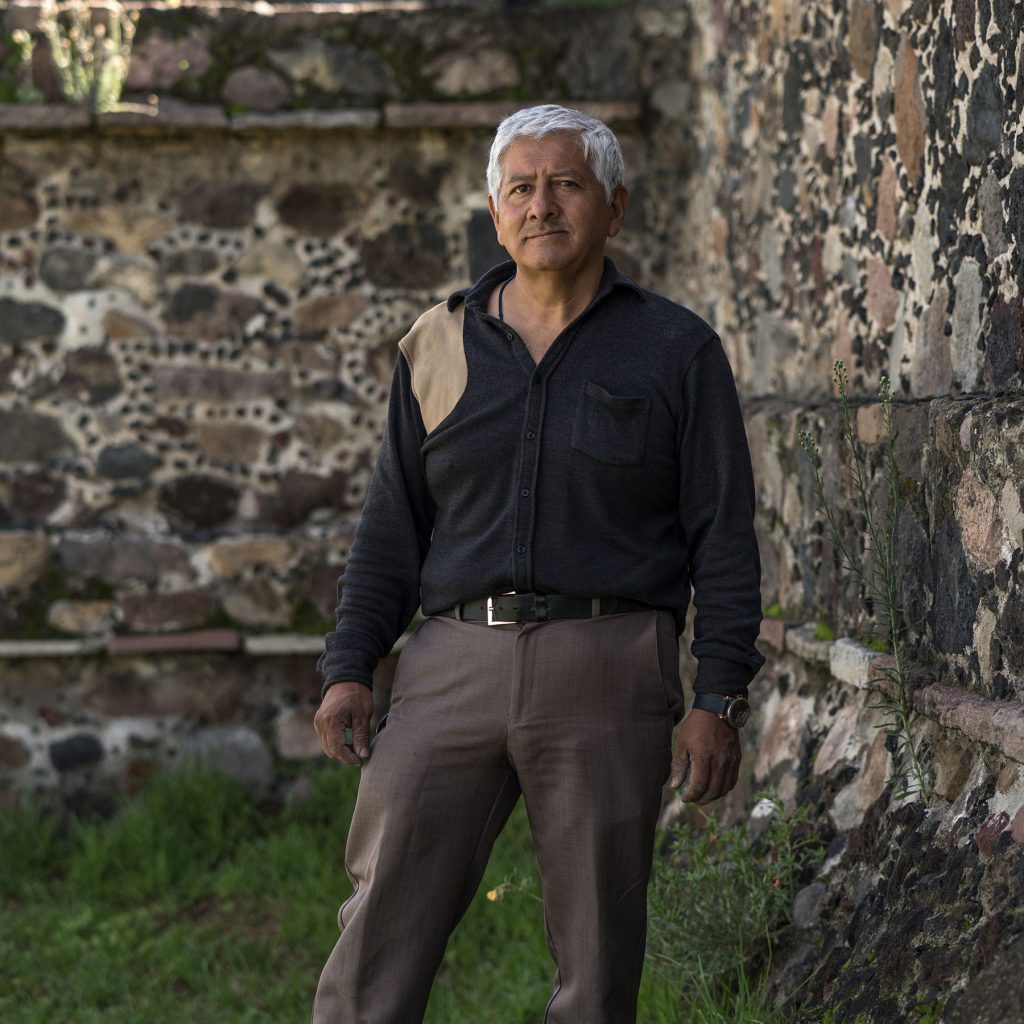An Homage to Teotihuacan
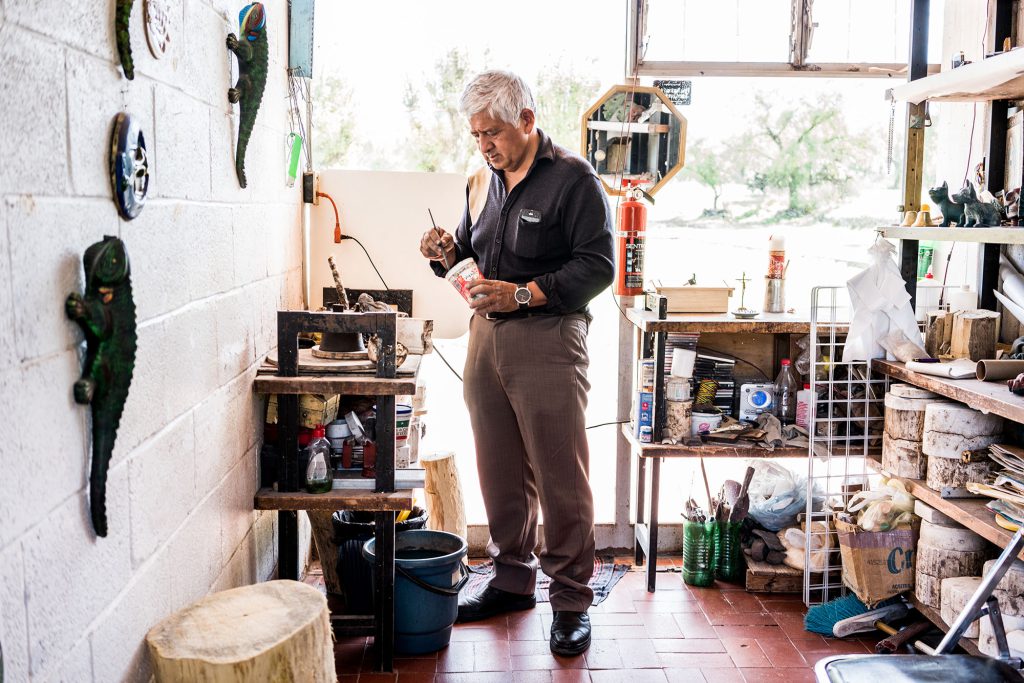
The ruins of Teotihuacan, just outside Mexico City, are Mexico’s most popular archaeological attraction. On a busy weekend, the line to the towering Pyramid of the Sun goes all the way down its 248 stairs and wraps halfway around its massive base. Of course, there are a lot of souvenir hawkers. The fabled Avenue of the Dead running through the heart of the ruins is noisy with the shouts of people selling obsidian blades, jaguar noisemakers, and crystals that supposedly channel ancient mystical powers.
Nestled between the Aztec masks, novelty sombreros, and tequila shot glasses sits Gabriel Vistrain Andrade’s odd little shop. Dark and sparsely decorated save for a couple of sculptures in the window, it looks more like a workroom. Here, the 58-year-old artist is quietly holed up inside, creating incredibly intricate carved sculptures that bring the long-dead Teotihuacan society back to life.
Vistrain holds up one of his art pieces: a half-flesh, half-skull head made of clay. He decorated one side with a god of fertility, storms, and life, while the other shows a god tied to death and fire. The piece blurs the line between archaeological replica and modern invention, between tourist trinket and valuable art. The skull isn’t a copy of anything ever found at Teotihuacan but more like something the ancient peoples here might have made if they were alive today.
“I wanted something that was essentially Teotihuacan,” says Vistrain. “It’s like an homage.”
The head symbolizes Teotihuacan’s seasons, which flip between a verdant green during the rainy summer and autumn, and a withered brown during the winter and spring. The peoples who lived here long ago clearly appreciated the contrast too, based on their iconography and architecture; some experts even say that Teotihuacan’s two major pyramids (commonly called the Pyramids of the Moon and the Sun) represent the wet and dry seasons.
Vistrain wants his art to help him communicate with both 2,000-year-old artists and the tourists who come into his shop. With no formal training in archaeology, he has become a student of iconography in order to create scenes and tableaux that are almost hypnotic. In doing so, he walks a fascinating tightrope between cultural tradition and creation that, when done well, helps us all feel more connected to our past.
The ruins of Teotihuacan are a vast archaeological complex. From the top of the Temple of the Sun—the largest exposed pyramid in Mesoamerica—you get a commanding view of the surrounding valley that some say held as many as 200,000 people and was one of the largest cities in the New World, filled with mysterious tunnels, stunning murals, and untold offerings to gods whose names have long been forgotten.
The city of Teotihuacan was built around the first or second century B.C., the same time the Roman Republic was dominating the Mediterranean. Like Rome, Teotihuacan had a huge impact on the surrounding region. Its peoples traded throughout Mesoamerica and likely conquered sites as far away as the mighty, ancient Maya city of Tikal in modern-day Guatemala. But unlike the Maya, the Teotihuacanos had no form of writing, so much of their politics, culture, and religion were lost or co-opted by later civilizations after Teotihuacan mysteriously collapsed around the eighth century. Scientists don’t even know the site’s true name. (Teotihuacan and all its structures were named hundreds of years later by the Mexica, or Aztecs, as the Spanish called those who settled nearby in what is now Mexico City in the 14th century.) All we have is their artwork and stone monuments.
But to the trained eye, artwork can say a lot. Iconography is extremely diverse across Mesoamerica, with stark differences between ancient traditions. For instance, the Maya used fluid lines to depict actual kings and everyday life, while the Mexica (or Aztec) preferred strong edges showing supernatural creatures and sacrifice rites. Teotihuacan art, in contrast, had a far different aesthetic, showing florid scenes of ceremonies and supernatural events in a boxy style.
When Vistrain set up shop at Teotihuacan in 1989, he didn’t know any of this. He had grown up in a nearby town, working in his father’s pharmacy in the days when pharmacists made drugs by hand. (His father’s shop was so timeless that a company bought it and reassembled it in a Monterrey museum.) But he wanted to be an artist, so he opened a shop and started carving clocks for tourists.
Vistrain quickly noticed that while plenty of souvenirs replicated either the Maya or Mexica style, none captured what he saw in Teotihuacan. He began poring through images at the site and in magazines, copying them and memorizing their lines. Soon he was carving them onto a friend’s ceramics and then onto his own using saw blade teeth, cactus spines, and even his father’s old tools—such as his wood-handled pill spatula. The decorations became incredibly detailed, scrupulously accurate scenes of gods, nature, and ceremonial life in Teotihuacan. Some of them are so precise you need a magnifying glass to appreciate the intricacies. (Vistrain says his trick for carving these images is to not look directly but to use his peripheral vision.)
“Gabriel’s work is unique—no other artisan in Teotihuacan makes what Gabriel does,” writes Sergio Gómez Chávez, a prominent archaeologist who excavated the tunnels under the nearby Temple of the Feathered Serpent and a long-time client and friend of Vistrain’s. “People who know how to appreciate the work of a great artisan recognize in Gabriel’s work care and dedication, as well as a deep knowledge of the ancient art of Teotihuacan.”
More than any other place in Mesoamerica, Teotihuacan has come to symbolize unanswerable questions. Who were the Teotihuacanos? How did they rise to dominate the region? Why did they fall? Where did they go? These mysteries go back long before the Spanish arrived and have always been frustrating for the expert yet captivating for the layperson. Archaeologists attempt to glean clues from the subtlest markings, while enthusiasts concoct fantastical supernatural explanations to explain the people who lived there.
Vistrain, for his part, says making hyper-detailed carvings in the Teotihuacan style gives him a special view back in time. He relates to the peoples of Teotihuacan in a way that few can. “It gives us a vision of how they think. We don’t know their language, but one form of language is painting. It transmits their vision and their ideas and their way of thinking to now,” he says. “All of us who are artists want to do this—to transcend time.”
Through his work, Vistrain has developed a special affection for the storm and fertility god because the god reminds him of the wet season. The artist’s face lights up when he speaks of the field behind his shop that turns into a network of tiny rivers, like the myriad lines on his art. The original artists of Teotihuacan seemingly had a similar affection: The city looked forward to the annual rains as a return of life and fertility.
Mary Katherine Scott, a visiting assistant professor at the University of Wyoming who has spent a decade doing ethnographic studies of souvenir artisans in the Yucatán, notes that archaeologists have sometimes looked to such artisans to help interpret barely visible markings on stone blocks. “These artisans, they pore over books, and they make these replicas,” she says. “They’re just very visually knowledgeable.”
As an art historian, Scott chafes at the distinction some draw between good art (in museums) and bad art (sold to tourists on the roadside). She freely admits to buying every sort of trinket, from the cheap plastic keychain to the wood statue, handwrought by a master carver.
“Objects tell you more about the relationships between people than anything else,” she says. Souvenirs like those in Vistrain’s shop help to connect not just tourists to a place but also ancient artists to modern ones. “Just because the people may not be alive anymore doesn’t mean there’s not a relationship there.”
Vistrain agrees, sitting in his tiny store littered with books filled with sketches of images from a long-dead civilization. The day I was there in April, he sold an intricately carved skull that had dropped from a shelf and broken. The customer, who owned a trendy hotel, loved the ancient feeling created by all the cracks. For a brief moment, the artist and customer seemed to connect over a shared aesthetic. Both saw a reflection of the old in something new. And for Vistrain, that’s what it’s all about—connecting people with the artists of Teotihuacan.
“[Art] is what they gave to the future generations. That’s how we understand them,” he says quietly about his ancient muses. “I think it’s a passion that will last all of my life.”

























